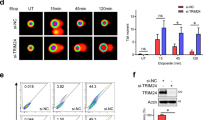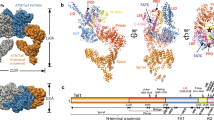Abstract
The related kinases ATM (ataxia-telangiectasia mutated) and ATR (ataxia-telangiectasia and Rad3-related) phosphorylate a limited number of downstream protein targets in response to DNA damage. Here we report a new pathway in which ATM kinase signals the DNA damage response by targeting the transcriptional cofactor Strap. ATM phosphorylates Strap at a serine residue, stabilizing nuclear Strap and facilitating formation of a stress-responsive co-activator complex. Strap activity enhances p53 acetylation, and augments the response to DNA damage. Strap remains localized in the cytoplasm in cells derived from ataxia telangiectasia individuals with defective ATM, as well as in cells expressing a Strap mutant that cannot be phosphorylated by ATM. Targeting Strap to the nucleus reinstates protein stabilization and activates the DNA damage response. These results indicate that the nuclear accumulation of Strap is a critical regulator in the damage response, and argue that this function can be assigned to ATM through the DNA damage-dependent phosphorylation of Strap.
This is a preview of subscription content, access via your institution
Access options
Subscribe to this journal
Receive 12 print issues and online access
$209.00 per year
only $17.42 per issue
Buy this article
- Purchase on Springer Link
- Instant access to full article PDF
Prices may be subject to local taxes which are calculated during checkout







Similar content being viewed by others
References
Zhou, B.B. & Elledge, S.J. The DNA damage response: putting checkpoints in perspective. Nature 408, 433–439 (2000).
Abraham, R.T. Cell cycle checkpoint signalling through the ATM and ATR kinases. Genes Dev. 15, 2177–2196 (2001).
Khanna, K.K., Lavin, M.F., Jackson, S.P. & Mulhern, T.D. ATM, a central controller of cellular responses to DNA damage. Cell Death Differ. 8, 1052–1065 (2001).
Shiloh, Y. ATM and ATR: networking cellular responses to DNA damage. Curr. Opin. Genet. Dev. 11, 71–77 (2001).
Walworth, N.C. Cell-cycle checkpoint kinases: checking in on the cell cycle. Curr. Opin. Cell Biol. 12, 697–704 (2000).
Canman, C.E. et al. Activation of the ATM kinase by ionizing radiation and phosphorylation of p53. Science 281, 1677–1679 (1998).
Khosravi, R. et al. Rapid ATM-dependent phosphorylation of MDM2 precedes p53 accumulation in response to DNA damage. Proc. Natl Acad. Sci. USA 96, 14973–14977 (1999).
Maya, R. et al. ATM-dependent phosphorylation of Mdm2 on serine 395: role in p53 activation by DNA damage. Genes Dev. 15, 1067–1077 (2001).
Cortez, D., Wang, Y., Qin, J. & Elledge, S.J. Requirement of ATM-dependent phosphorylation of BRCA1 in the DNA damage response to double-strand breaks. Science 286, 1162–1166 (1999).
Hirao, A. et al. DNA damage-induced activation of p53 by the checkpoint kinase Chk2. Science 287, 1824–1827 (2000).
Shieh, S.Y., Ahn, J., Tamai, K., Taya, Y. & Prives, C. The human homologues of checkpoint kinases Chk1 and Cds1 (Chk2) phosphorylate p53 at multiple DNA damage-inducible sites. Genes Dev. 14, 289–300 (2000).
Falck, J., Mailand, N., Syljuasen, R.G., Bartek, J. & Lukas, J. The ATM–Chk2–Cdc25A checkpoint pathway guards against radioresistant DNA synthesis. Nature 410, 842–847 (2001).
Stevens, C., Smith, L. & La Thangue, N.B. Checkpoint kinase activates E2F-1 in response to DNA damage. Nature Cell Biol. 5, 401–409 (2003).
Peng, C.Y. et al. Mitotic and G2 checkpoint control: Regulation of 14-3-3 protein binding by phosphorylation of Cdc25C on serine-216. Science 277, 1501–1505 (1997).
Lakin, N.D. & Jackson, S.P. Regulation of p53 in response to DNA damage. Oncogene 18, 7644–7655 (1999).
Hollstein, M., Sidransky, D., Vogelstein, B. & Harris, C.C. p53 mutations in human cancers. Science 253, 49–53 (1991).
Chehab, N.H., Malikzay, A., Appel, M. & Halazonetis, T.D. Chk2/hCds1 functions as a DNA damage checkpoint in G1 by stabilizing p53. Genes Dev. 14, 278–288 (2000).
Giaccia, A.J. & Kastan, M.B. The complexity of p53 modulation: emerging patterns from divergent signals. Genes Dev. 12, 2973–2983 (1998).
Meyn, M.S. Ataxia-telangiectasia, cancer and the pathobiology of the ATM gene. Clin. Genet. 55, 289–304 (1999).
Bell, D.W. et al. Heterozygous germ line hCHK2 mutations in Li-Fraumeni syndrome. Science 286, 2528–2531 (1999).
Sakaguchi, K. et al. DNA damage activates p53 through a phosphorylation–acetylation cascade. Genes Dev. 12, 2831–2841 (1998).
Liu, L. et al. p53 sites acetylated in vitro by PCAF and p300 are acetylated in vivo in response to DNA damage. Mol. Cell. Biol. 19, 1202–1209 (1999).
Avantaggiati, M.L. et al. Recruitment of p300/CBP in p53-dependent signal pathways. Cell 89, 1175–1184 (1997).
Shikama, N. et al. A novel cofactor for p300 that regulates the p53 response. Mol. Cell 4, 365–376 (1999).
Demonacos, C., Krstic-Demonacos, M. & La Thangue, N.B. A TPR motif cofactor contributes to p300 activity in the p53 response. Mol. Cell 8, 71–84 (2001).
Bakkenist, C.J. & Kastan, M.B. DNA damage activates ATM through intramolecular autophosphorylation and dimer dissociation. Nature 421, 499–506 (2003).
Barlow, C. et al. Loss of the ataxia-telangiectasia gene product causes oxidative damage in target organs. Proc. Natl. Acad. Sci. USA 96, 9915–9919 (1999).
Beamish, H. & Lavin, M.F. Radiosensitivity in ataxia-telangiectasia: anomalies in radiation-induced cell cycle delay. Int. J. Radiat. Biol. 65, 175–184 (1994).
Sarkaria, J.N. et al. Inhibition of phosphoinositide 3-kinase related kinases by the radiosensitizing agent wortmannin. Cancer Res. 58, 4375–4382 (1998).
Stein, R.C. & Waterfield, M.D. PI3-kinase inhibition: a target for drug development? Mol. Med. Today 6, 347–357 (2000).
Di Tullio, R.A. et al. 53BP1 functions in an ATM-dependent checkpoint pathway that is constitutively activated in human cancer. Nature Cell Biol. 4, 998–1002 (2002).
Chan, H-M & La Thangue, N.B. p300/CBP proteins: HATs for transcriptional bridges and scaffolds. J. Cell Sci. 114, 2363–2373 (2001).
Gu, W. & Roeder, R.G. Activation of p53 sequence specific DNA binding by acetylation of the p53 C-terminal domain. Cell 90, 595–606 (1997).
Freedman, D.A. & Levine, A.J. Nuclear export is required for degradation of endogenous p53 by MDM2 and human papillomavirus E6. Mol. Cell. Biol. 18, 7288–7293 (1998).
Crighton, D. et al. p53 represses RNA polymerase III transcription by targeting TBP and inhibiting promoter occupancy by TFIIIB. EMBO J. 22, 2810–2820 (2003).
Brummelkamp, T.R., Bernards, R. & Agami, R. A system for stable expression of short interfering RNAs in mammalian cells. Science 296, 550–553 (2002).
Acknowledgements
We thank M. Caldwell for assistance in preparing the manuscript. This work was supported by the Medical Research Council, the Leukaemia Research Fund, Cancer Research UK and the European Union. We thank M. B. Kastan for the wild-type and kinase-dead ATM expression vectors.
Author information
Authors and Affiliations
Corresponding author
Ethics declarations
Competing interests
The authors declare no competing financial interests.
Supplementary information
Supplementary Figures
Fig. S1, Fig. S2, Fig. S3, Fig. S4 (PDF 576 kb)
Rights and permissions
About this article
Cite this article
Demonacos, C., Krstic-Demonacos, M., Smith, L. et al. A new effector pathway links ATM kinase with the DNA damage response. Nat Cell Biol 6, 968–976 (2004). https://doi.org/10.1038/ncb1170
Received:
Accepted:
Published:
Issue Date:
DOI: https://doi.org/10.1038/ncb1170
This article is cited by
-
Cofactor Strap regulates oxidative phosphorylation and mitochondrial p53 activity through ATP synthase
Cell Death & Differentiation (2015)
-
Human single-stranded DNA binding proteins are essential for maintaining genomic stability
BMC Molecular Biology (2013)
-
EZH2-mediated H3K27 trimethylation mediates neurodegeneration in ataxia-telangiectasia
Nature Neuroscience (2013)
-
TTC5 is required to prevent apoptosis of acute myeloid leukemia stem cells
Cell Death & Disease (2013)
-
Arginine methylation regulates the p53 response
Nature Cell Biology (2008)



